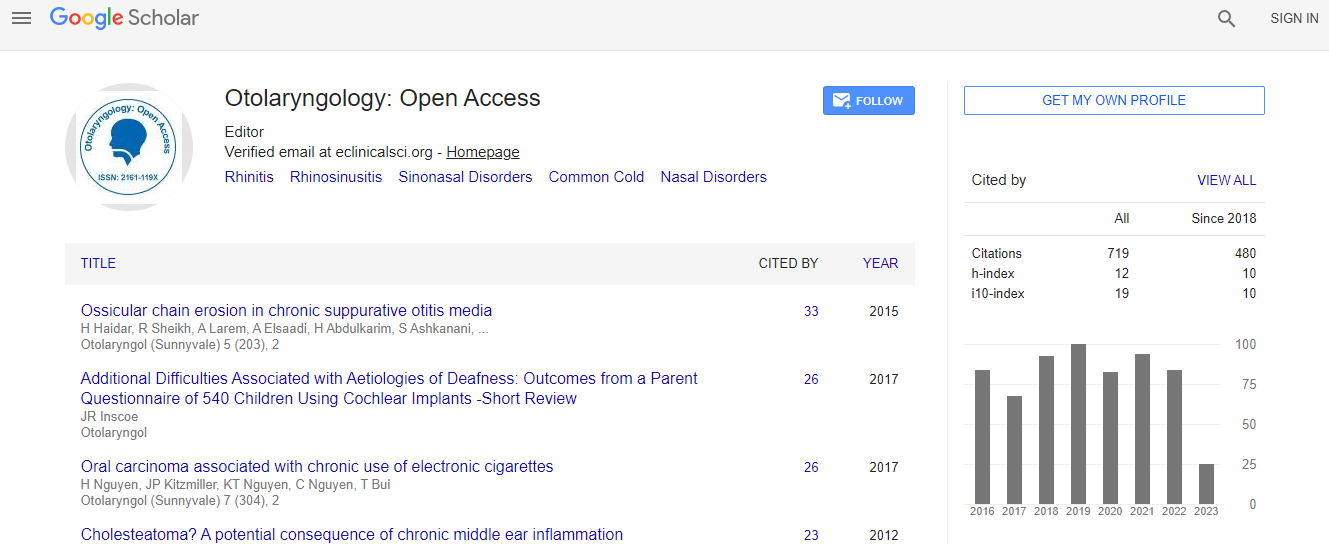Our Group organises 3000+ Global Conferenceseries Events every year across USA, Europe & Asia with support from 1000 more scientific Societies and Publishes 700+ Open Access Journals which contains over 50000 eminent personalities, reputed scientists as editorial board members.
Open Access Journals gaining more Readers and Citations
700 Journals and 15,000,000 Readers Each Journal is getting 25,000+ Readers
Google Scholar citation report
Citations : 925
Otolaryngology: Open Access received 925 citations as per Google Scholar report
Otolaryngology: Open Access peer review process verified at publons
Indexed In
- Index Copernicus
- Google Scholar
- Sherpa Romeo
- Open J Gate
- Genamics JournalSeek
- RefSeek
- Hamdard University
- EBSCO A-Z
- OCLC- WorldCat
- Publons
- Geneva Foundation for Medical Education and Research
- ICMJE
Useful Links
Recommended Journals
Related Subjects
Share This Page
Advances in surgical wound management
5th Global Summit and Expo on Head, Neck and Plastic Surgery
Mark S Granick
Rutgers New Jersey Medical School, USA
ScientificTracks Abstracts: Otolaryngol (Sunnyvale)
Abstract
Statement of the Problem: The concept of surgical wound debridement was developed by military field surgeons and has remained as a sharp debridement technique for over 300 years until the development of new surgical technology in the 21st century. Aim: The purpose of this presentation is to demonstrate the validity of new technologies and their role in the treatment of wounds. Methodology: A review of the English language literature on surgical wound debridement is presented along with the author�s personal surgical experience. Findings: Hydrosurgical technology was introduced about 15 years ago. The instrument delivered a high-powered beam of focused saline tangentially to the wound surface. The use of the device was found to be more effective and efficient at wound bed preparation than standard surgical technique. The latest innovation involves direct contact low frequency ultrasound. This technology controls mist dispersion, biofilm removal and wound cleansing more effectively than previous methods. In addition, it is more versatile and has the added features of bone cutting and curetting of tissues. Conclusions & Significance: Surgical wound debridement is a technology driven and advancing field. The latest devices have more versatility and a greater ability to clean wounds of all types and remove diseased bone as well as biofilm. There is a possibility that the technology can be used to salvage exposed metallic implants. Furthermore, it may be adaptable to pretreating surgical incision sites to minimize surgical site infections.Biography
Mark S Granick is the tenured Professor of Surgery and Chief of Plastic Surgery in the Department of Surgery. He has a 25 years history of academic plastic surgical experience. He began with a BA from Cornell University and MD from Harvard Medical School. He has performed his Residency training at Harvard and at the University of Pittsburgh. He is certified by the American Boards of Plastic Surgery and of Otolaryngology, Head and Neck Surgery. He is very active on the internatizzonal academic scene and has taught many courses and lectured throughout the world. He is internationally known for his expertise in wound surgery and technology.
Email: mgranickmd@njms.rutgers.edu

 Spanish
Spanish  Chinese
Chinese  Russian
Russian  German
German  French
French  Japanese
Japanese  Portuguese
Portuguese  Hindi
Hindi 
